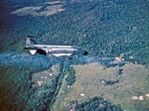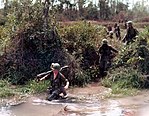Vilcasuamanian Bush War
This article is incomplete because it is pending further input from participants, or it is a work-in-progress by one author. Please comment on this article's talk page to share your input, comments and questions. Note: To contribute to this article, you may need to seek help from the author(s) of this page. |
| Vilcasuamanian Bush War | |||||||
|---|---|---|---|---|---|---|---|
| Part of the Phoney War | |||||||
| |||||||
| Belligerents | |||||||
|
Right-wing militias |
| ||||||
| Commanders and leaders | |||||||
|
|
| ||||||
| Casualties and losses | |||||||
| 70,000–80,000 (total Vilcasuamanian dead); 2,000 disappeared; 550,000 internally displaced | |||||||
The Vilcasuamanian Bush War (Ruttish: Vilkasuamanos Krūmo Karas) was a conflict between the government of the Republic of Vilcasuamanas and various left-wing movements and armed groups. The conflict began in the early 1960s and quickly escalated into a full-scale guerilla war. At its height, the war drew in several states from Asteria Inferior and Superior alike, as well as Valentir, with involvement ranging from material support to active intervention. The Na Naoimh Peace Accords in 1976 demobilized most of the guerilla forces, while forcing the military government to concede significant steps towards democratization; certain factions, however, such as the Revolutionary Democratic Army of Vilcasuamanas (RDVA) would continue the fight until 1991.
Open conflict broke out on May Day, 1961, after a crackdown on trade union leaders sparked an uprising in the commune of Marketalas. It was a reaction to the repressive policies of military dictator Mauricijus Sprogys, who had ruled the country since 1958, but was caused by deep-rooted issues such as land reform, anti-indigenous policies, corruption, and income inequality. In 1963, the Workers and Peasants' Solidarity Front (Ruttish: Darbuotojų ir Valstiečių Solidarumo Frontas, DVSF) was formed as a loose, ideologically-heterogenous alliance of rural guerilla groups, as well as the urban, Tiberian 27th of July Movement (L-27). The conflict became characterized by unconventional warfare, particularly in the Scythian rainforest region of the country. Foreign involvement, initially in the form of military advisors, would escalate dramatically as part of the anti-leftist measures of the Phoney War; Vilcasuamanas invoked the mutual defense clause of the Joint Defense Force, and by 1972 there were several thousand Federation, Mariranan, and Nimearian troops "in-country".
The government-aligned forces conducted vast search and destroy operations against the rural guerillas; these bloody tactics were controversial in both the Federation and in Vilcasuamanas, as their effectiveness against the insurgents was dubious. From 1974, Federation troops began a gradual withdrawal, straining the Vilcasuamanian armed forces that had relied on Federation support. Fearing the unpopularity of the war among his supporters threatened to undermine his regime, Sprogys made concessions to the L-27 movement, restoring the Seimas and releasing hundreds of political prisoners. This brought the DVSF to the negotiating table as well, and the New Haven Peace Accords of 1976 officially ended the conflict, with Sprogys pledging to hold free elections. In 1976, the first general elections were held, with the military relinquishing power and allowing for presidential elections shortly after Sprogys' death in 1978. However, the CAL refused to demobilize and broke with the DVSF following the New Haven Agreement, continuing a low-level asymmetric conflict for fifteen years.
Although estimates vary, scholars believe around 75,000 Vilcasuamanians were killed in the course of the war; approximately 6,000 foreign troops were also killed between 1970 and 1976. The war was also notorious for the human rights violations committed on both sides; the rebels forcibly recruited child soldiers, the government launched indiscriminate strategic bombing campaigns, and all combatants regularly executed civilians believed to be collaborating with the enemy. In the initial stage of the conflict, the Vilcasuamanian dictatorship significantly cracked down on civil liberties; Sprogys' government is thought to be responsible for nearly 2,000 forced disappearances during this period. The war precipitated a vast refugee crisis as disaffected Vilcasuamanians migrated to Nimear and Satucin, leading to tensions in both of those nations. However, the return to democracy in Vilcasuamanas can also be credited to the conflict, as both the insurgents and the government's allies pressured the Sprogys government to liberalize and return to traditional party politics, initiating the Fifth Republic.







